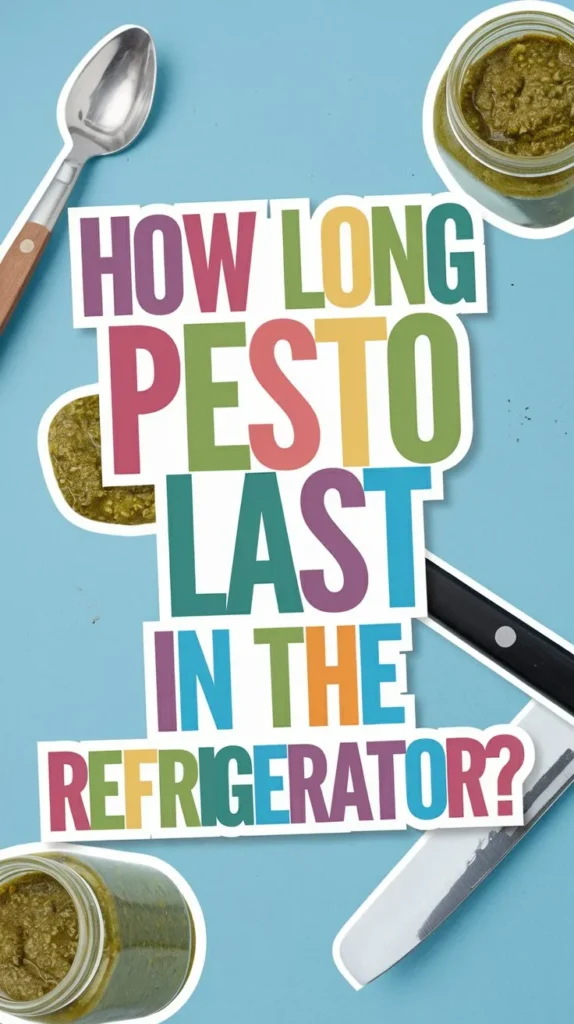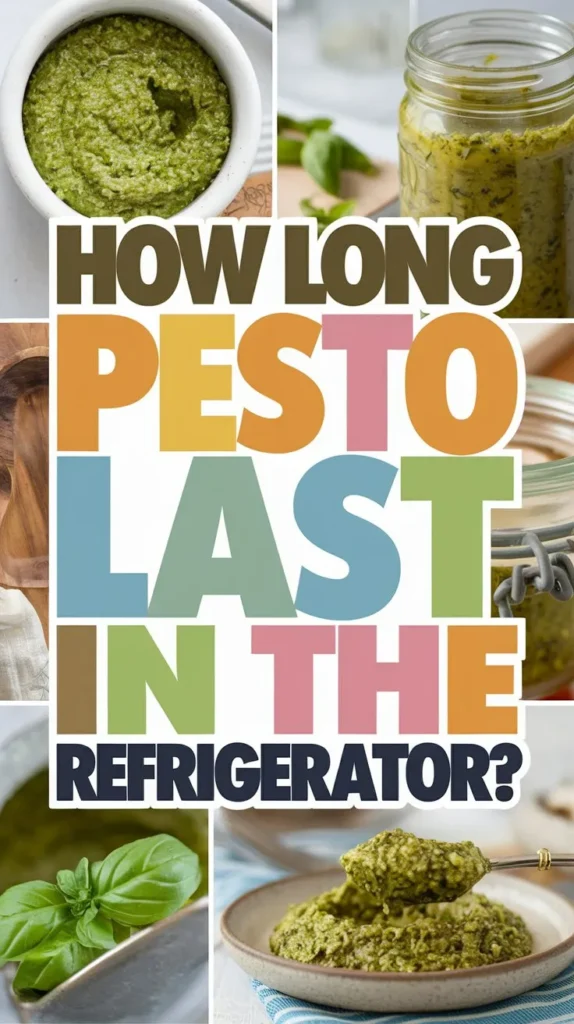How Long Does Pesto Last in the Refrigerator?
You’ve probably wondered how long that delicious homemade pesto will last in your fridge. The answer depends on several factors, including how you store it and whether it’s homemade or store-bought.
Generally, homemade pesto has a shorter shelf life, typically lasting up to a week when refrigerated properly. But what about store-bought pesto, and how can you guarantee your pesto stays fresh for as long as possible?
You’ll want to know the signs of spoilage and the best storage methods to get the most out of your pesto – and that’s just the beginning.
At a Glance
- Homemade pesto can last up to one week in the refrigerator when stored in an airtight container at a temperature below 40°F (4°C).
- Store-bought pesto may have a longer shelf life due to added preservatives, typically ranging from 6 to 12 months.
- To maximize freshness, store pesto in an airtight container, pressing plastic wrap directly onto the surface, and keeping it refrigerated.
- Proper storage in the refrigerator, tightly sealed and away from light, will help extend the shelf life of store-bought pesto.
- Freezing pesto can extend its shelf life up to six months, making it ideal for adding to soups, stews, and sauces.

Shelf Life of Fresh Pesto
As you open a fresh jar of pesto, you might wonder how long you have to enjoy it before it goes bad.
The shelf life of fresh pesto largely depends on the quality of the ingredients, storage conditions, and personal tolerance for spoilage. When made with fresh herbs like basil, garlic, and pine nuts, pesto can be quite perishable.
Generally, homemade pesto can last up to one week in the refrigerator, while store-bought varieties may have a longer shelf life due to added preservatives.
To maximize freshness, it’s crucial to store pesto in an airtight container, such as a glass jar with a tight-fitting lid, and keep it refrigerated at a temperature below 40°F (4°C).
You can also consider freezing pesto to extend its shelf life. When frozen, pesto can last for up to six months.
When using fresh basil, opt for a sweet basil variety, which has a milder flavor and aroma, making it ideal for pesto.
Store-Bought Pesto Expiration Dates
One jar of store-bought pesto typically comes with an expiration date or a “best by” date printed on the label.
This date serves as a guideline for the manufacturer’s guarantee of prime quality and flavor. However, you should know that pesto regulations don’t require a specific expiration date, so brand variations may differ.
When it comes to store-bought pesto, the expiration date usually ranges from 6 to 12 months.
Some brands may have a shorter or longer shelf life, but generally, you can expect it to last around 6-9 months in the refrigerator.
After opening, it’s recommended to consume store-bought pesto within a week or two for the best flavor and texture.
It’s essential to remember that the expiration date isn’t a hard-and-fast rule.
You should always check the pesto’s appearance, smell, and taste before consuming it, even if it’s within the expiration date range.
Keep in mind that proper storage in the refrigerator, tightly sealed and away from light, will help extend the shelf life of your store-bought pesto.
Signs of Spoiled Pesto
You’ve checked the expiration date, but how can you be certain your pesto is still good to use?
Even if it’s within the expiration date, pesto can still go bad if not stored properly.
Here are some signs to look out for to determine if your pesto has gone spoiled:
- Off smell: If your pesto has a strong, unpleasant odor, it’s likely gone bad. Fresh pesto should have a bright, herby aroma.
- Moldy texture or slimy consistency: Check the pesto for any visible mold or a slimy texture. If you notice either of these, it’s time to toss the pesto.
- Sluggish or separated appearance: Fresh pesto should have a vibrant green color and a smooth consistency. If it looks dull, separated, or has an unusual color, it may be past its prime.
If you notice any of these signs, it’s best to err on the side of caution and discard the pesto.
Consuming spoiled pesto can lead to foodborne illness, so it’s better to be safe than sorry.
Proper Storage for Pesto
Properly storing pesto is crucial to extending its shelf life and maintaining its flavor and texture.
You want to keep your delicious homemade or store-bought pesto fresh for as long as possible. To do this, you’ll need to store it in an air-tight container, which will prevent air from getting in and spoiling the pesto.
Glass jars with tight-fitting lids are ideal for storing pesto, as they keep air out and maintain the pesto’s flavor and aroma.
When storing pesto in a glass jar, make sure to press plastic wrap or wax paper directly onto the surface of the pesto before closing the lid.
This will prevent air from seeping in and causing the pesto to turn brown or develop off-flavors. Additionally, keep the jar away from direct sunlight and heat sources, as these can cause the pesto to spoil more quickly.
Freezing Pesto for Longer Storage
While pesto can last for several weeks when stored in the fridge, freezing it’s an excellent way to extend its shelf life even further.
By freezing pesto, you can enjoy it throughout the year, even when fresh basil is out of season.
To freeze pesto, simply transfer the desired amount to an airtight container or freezer bag, making sure to remove as much air as possible before sealing.
You can also portion pesto into ice cube trays to create convenient Pesto cubes that can be easily added to dishes as needed.
Make sure you have enough Freezer space to store your pesto containers or bags.
When freezing pesto, it’s crucial to label the containers or bags with the date and contents, so you can easily keep track of how long they’ve been stored.
Frozen pesto is perfect for adding to soups, stews, and sauces, and it’s also great as a dip for vegetables or crackers.
Pesto Safety Guidelines
When handling and storing pesto, it’s vitally necessary to prioritize safety to avoid spoilage and foodborne illnesses.
You must verify your hands are clean before handling pesto, and wash them thoroughly afterward. Use clean utensils and containers to prevent cross-contamination. Always check the pesto’s appearance and smell before consuming it. If you notice any mold, sliminess, or off-odors, discard it immediately.
Proper pesto handling is key to preventing pesto contamination.
Store pesto in airtight containers, pressing plastic wrap directly onto the surface to prevent air from reaching it. Keep it refrigerated at a temperature of 40°F (4°C) or below.
When freezing pesto, transfer it to airtight containers or freezer bags, making sure to remove as much air as possible before sealing. By following these guidelines, you’ll markedly reduce the risk of pesto contamination and foodborne illnesses, guaranteeing you can enjoy your pesto safely for a longer period.
Reviving Old or Stale Pesto
Essentiality seeps out of pesto over time, leaving it stale and lackluster.
You’ve invested time and effort into crafting the perfect basil blend, and it’s disheartening to see it lose its vibrancy.
Fear not, for you can revive your pesto and restore its flavor.
To breathe new life into your pesto, try the following:
- Add a squeeze of fresh lemon juice: The acidity will help brighten the flavors and balance out the richness.
- Mix in some fresh herbs: Chopped parsley, basil, or cilantro can add a much-needed boost of freshness.
- Blend in some grated garlic: A small amount can help awaken the dormant flavors and add depth to your pesto.
FAQs
Can I Use Pesto as a Substitute for Mayonnaise in Recipes?
You can definitely use pesto as a mayonnaise alternative, but keep in mind it’ll drastically change the flavor profile; pesto’s herby, garlicky taste will add a bold twist to your dish, so adjust recipes accordingly for a delicious, creamy result.
Is Homemade Pesto Suitable for Canning or Preserving?
You’re wondering if your homemade pesto is suitable for canning or preserving. While it’s possible, you’ll need to follow safe canning methods to guarantee a long shelf life, as improperly preserved pesto can spoil quickly, making you sick.
Can I Make Pesto With Other Nuts Instead of Pine Nuts?
You can definitely experiment with other nuts in your pesto recipe. The Almond option adds a sweet, subtle flavor, while the Walnut alternative provides a rich, earthy taste, both offering a delicious twist on traditional pine nuts.
Can Pesto Be Used as a Marinade for Grilled Meats?
You can definitely use pesto as a marinade for grilled meats, and it’s especially great with grilled chicken, as it enhances meat flavors without overpowering them, leaving you with a deliciously herby and savory dish.
Is Pesto Safe to Consume During Pregnancy or Breastfeeding?
You’re wise to wonder if pesto’s safe during pregnancy or breastfeeding. Rest assured, as a nutritious condiment, pesto’s generally okay, supporting fetal safety and healthy pregnancy nutrition, but always check with your healthcare provider to confirm.












DK Jacks is a passionate food enthusiast, recipe developer, and culinary explorer. With a love for both traditional and innovative flavors, DK brings a fresh perspective to the kitchen. When not experimenting with new ingredients, you’ll find DK capturing food moments through the lens or sharing cooking tips with fellow foodies.🍽️📸✨







